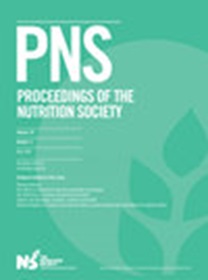爱尔兰岛上爱尔兰成年人的膳食蛋白质摄入特点
IF 4.5
2区 医学
Q1 NUTRITION & DIETETICS
引用次数: 0
摘要
将膳食蛋白质摄入量从动物来源转向植物来源被认为是维持世界粮食消费和维护地球资源的一条途径(1)。然而,要促进这种转变,就必须确定膳食蛋白质模式的基本特征。本研究旨在考察爱尔兰岛的膳食蛋白质摄入量,以确定影响蛋白质摄入量的人口特征和食物来源。研究分析了英国国家膳食营养调查(NDNS 2016-2019)北爱尔兰子队列(2)和爱尔兰国家成人营养调查(2008-2010)(3)。这两项调查都采用了四天的食物日记,最终抽取了1484名18-64岁的成年人样本(NANS;n=1274;NI NDNS;n=210)。计算了总人口的蛋白质日平均摄入量(MDI;总能量百分比,TE),并根据低、中、高蛋白质摄入量(%TE)将人口分为三个梯度组。采用秩方和单因子方差分析(带协变量(年龄和体重指数)),并酌情进行多重比较校正(P<0.005),考察了这些三等分组中人群特征、能量 MDI、关键营养素(%TE 或每 10 兆焦耳)和贡献食物来源的差异。总体而言,17.1% 的 TE 来自蛋白质,77% 的参与者达到了欧洲食物安全局建议的 0.83 克/千克/体重的蛋白质 DRV (4)。蛋白质摄入量最高的三分位数和最低的三分位数之间的差异为7.8% TE(21.2% TE vs 13.4% TE),高蛋白消费者的能量摄入量(1734 ± 564千卡)低于低蛋白消费者(2185 ± 661千卡)。高蛋白消费者年龄较大(42.5 ± 12.8 岁),体重指数较高(27.7 ± 6.0 kg/m2)。与低蛋白消费者相比,他们的膳食纤维、钙、锌、钠、铁、叶酸和维生素 A、C、D 和 B12 的总摄入量(每 10 兆焦耳)较高(p<0.001),碳水化合物、脂肪和饱和脂肪的总摄入量(%TE)较低(p<0.001)。鸡肉、火鸡肉和菜肴"(18.3%)、"牛肉、小牛肉和菜肴"(12.8%)和 "鱼和鱼制品"(7.0%)在蛋白质摄入量中所占的比例,高摄入量组明显高于低摄入量组(分别为 10%、7.4%、4.4% TE;P<0.001)。与此相反,蛋白质摄入量最低组的人从膳食来源摄入的蛋白质明显较高,包括 "汉堡、香肠和肉制品(9.9% 对 5.9%)"、"白面包和面包卷"(6.9% 对 3.9%)、"土豆(包括薯片)"(4.1% 对 2.总体而言,动物蛋白质来源比植物蛋白质来源对每日蛋白质总摄入量的贡献更大,但蛋白质食物的摄入模式因蛋白质摄入水平而异。这些发现将有助于制定爱尔兰岛蛋白质摄入多样化的战略。本文章由计算机程序翻译,如有差异,请以英文原文为准。
Characterising dietary protein intake in Irish adults on the island of Ireland
Shifting dietary protein intakes from animal to plant-based sources is suggested as a path to sustain the world’s food consumption and maintain planetary resources (1) . However, to facilitate change, it is important to characterise baseline dietary protein patterns. This study aimed to examine dietary protein intakes on the island of Ireland in order to determine population characteristics and food sources influencing protein intake.Analyses were performed on the Northern Ireland sub cohort of the UK National Dietary Nutrition Survey (NDNS 2016-2019) (2) and the Irish National Adult Nutrition Survey (2008-2010) (3) . Both surveys used a four-day food diary and a final sample of 1484 adults, aged 18-64 years was extracted (NANS; n =1274 and NI NDNS; n=210). Mean daily intakes for protein (MDI; % total energy, TE) for the total population were calculated and the population was divided into three tertile groups based on low, medium and high protein intake (%TE). Differences in population characteristics, energy MDI, key nutrients (%TE or per 10MJ) and contributing food sources were examined across these tertiles, using chi-square and one-way ANOVA with covariates (age and BMI) and correcting for multiple comparisons as appropriate (P<0.005 ).Overall, 17.1% of TE was obtained from protein and 77% of participants met their protein DRV based on EFSA recommendations of 0.83g/kg/body weight (4). The difference in protein intakes between the highest and lowest tertiles was 7.8% TE (21.2 % TE vs 13.4% TE) with high protein consumers reporting lower energy intakes (1734 ± 564kcal) compared to low consumers (2185 ± 661 kcal). High protein consumers were older (42.5 ± 12.8 years) and had a higher BMI (27.7 ± 6.0 kg/m2 ). They also had higher MDI of dietary fibre, calcium, zinc, sodium, iron, folate and vitamins A, C, D and B12 (per 10MJ) (p<0.001) and lower MDI of carbohydrates, fat, saturated fat (%TE) in comparison to low consumers (p<0.001). The % contribution of ‘chicken, turkey and dishes’ (18.3%), ‘beef, veal and dishes’ (12.8%) and ‘fish and fish products (7.0%) to protein intakes were significantly higher in the high versus the low consumption group (10%, 7.4%, 4.4% TE respectively; P<0.001). In contrast, those in the lowest protein intake group had a significantly higher intakes of protein coming from dietary sources including ‘burgers, sausages and meat products (9.9 vs 5.9%), ‘white bread and rolls’ (6.9 vs 3.9%), ‘potatoes (including chips)’ (4.1 vs 2.9 %) and ‘cakes, pastries, buns and fruit pies’ (1.7 vs 0.8%) compared to high consumers.In general, animal protein sources contributed more to total daily protein intakes than plant sources, however, the pattern of protein foods differed according to level of protein intake. These findings will aid in the development of strategies to diversify protein intakes on the Island of Ireland.
求助全文
通过发布文献求助,成功后即可免费获取论文全文。
去求助
来源期刊
CiteScore
15.50
自引率
0.00%
发文量
190
审稿时长
6-12 weeks
期刊介绍:
Proceedings of the Nutrition Society publishes papers and abstracts presented by members and invited speakers at the scientific meetings of The Nutrition Society. The journal provides an invaluable record of the scientific research currently being undertaken, contributing to ''the scientific study of nutrition and its application to the maintenance of human and animal health.'' The journal is of interest to academics, researchers and clinical practice workers in both human and animal nutrition and related fields.

 求助内容:
求助内容: 应助结果提醒方式:
应助结果提醒方式:


